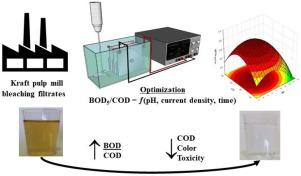当前位置:
X-MOL 学术
›
Process Saf. Environ. Prot.
›
论文详情
Our official English website, www.x-mol.net, welcomes your feedback! (Note: you will need to create a separate account there.)
Electrocoagulation of kraft pulp bleaching filtrates to improve biotreatability
Process Safety and Environmental Protection ( IF 7.8 ) Pub Date : 2021-03-01 , DOI: 10.1016/j.psep.2020.09.039 Eder Carlos Lopes Coimbra , Ann H. Mounteer , Andreiva Lauren Vital do Carmo , Marc Jaqueline Frank Michielsen , Lucas Alcântara Tótola , Júlia Pires Fujiara Guerino , Júlia Gabriela Alves Nogueira Gonçalves , Priscila Romana da Silva
Process Safety and Environmental Protection ( IF 7.8 ) Pub Date : 2021-03-01 , DOI: 10.1016/j.psep.2020.09.039 Eder Carlos Lopes Coimbra , Ann H. Mounteer , Andreiva Lauren Vital do Carmo , Marc Jaqueline Frank Michielsen , Lucas Alcântara Tótola , Júlia Pires Fujiara Guerino , Júlia Gabriela Alves Nogueira Gonçalves , Priscila Romana da Silva

|
Abstract Bleached kraft pulp mills generate large volumes of effluents usually treated by biological processes that don´t remove recalcitrant organic constituents. The present study was undertaken to evaluate the potential of electrocoagulation of acid (AcF) and alkaline (AlF) kraft pulp bleaching filtrates with Al and Fe electrodes to improve their biotreatability. Response surface methodology was used to predict the effects of initial pH, current density, and electrolysis time on biodegradability (BOD/COD). Biodegradability increases of 1.7–2.1-fold were obtained using optimized experimental conditions for each electrode-filtrate combination: AcF-Al (pH 7.9, 128 A/m², 49 min), AcF-Fe (pH 4.6, 104 A/m², 40 min), AlF-Al (pH 3.8, 150 A/m², 52 min) and AlF-Fe (pH 6.3, 101 A/m², 42 min). Electrocoagulation with Al electrodes was more efficient in removing color, phenols and estrogenic activity, but required longer reaction time and higher current density, while treatment with Fe electrodes resulted in lower toxicity to Daphnia similis. Electrocoagulation of both filtrates before combining them for biological treatment led to 88 % dissolved organic carbon (DOC) removal in a five-day biodegradability test, compared to only 27 % DOC removal from combined raw filtrates. The potential to increase overall pulp mill wastewater treatment efficiency using electrocoagulation prior to biological treatment was demonstrated.
中文翻译:

牛皮纸浆漂白滤液的电凝聚以提高生物可处理性
摘要 漂白硫酸盐纸浆厂产生大量废水,通常通过不去除顽固有机成分的生物工艺进行处理。本研究旨在评估使用铝和铁电极对酸性 (AcF) 和碱性 (AlF) 牛皮纸浆漂白滤液进行电凝聚以提高其生物可处理性的潜力。响应面方法用于预测初始 pH 值、电流密度和电解时间对生物降解性 (BOD/COD) 的影响。对于每种电极-滤液组合使用优化的实验条件,生物降解性提高了 1.7-2.1 倍:AcF-Al(pH 7.9,128 A/m²,49 分钟),AcF-Fe(pH 4.6,104 A/m²,40 min)、AlF-Al(pH 3.8,150 A/m²,52 分钟)和 AlF-Fe(pH 6.3,101 A/m²,42 分钟)。铝电极电凝在去除颜色、酚类和雌激素活性方面更有效,但需要更长的反应时间和更高的电流密度,而铁电极处理对水蚤的毒性较低。在将两种滤液合并用于生物处理之前对其进行电凝,在五天的生物降解性测试中去除了 88% 的溶解有机碳 (DOC),而从合并的原始滤液中仅去除了 27% 的 DOC。证明了在生物处理之前使用电凝聚提高制浆厂废水整体处理效率的潜力。在将两种滤液合并用于生物处理之前对其进行电凝,在五天的生物降解性测试中去除了 88% 的溶解有机碳 (DOC),而从合并的原始滤液中仅去除了 27% 的 DOC。证明了在生物处理之前使用电凝聚提高制浆厂废水整体处理效率的潜力。在将两种滤液合并用于生物处理之前对其进行电凝,在五天的生物降解性测试中去除了 88% 的溶解有机碳 (DOC),而从合并的原始滤液中仅去除了 27% 的 DOC。证明了在生物处理之前使用电凝聚提高制浆厂废水整体处理效率的潜力。
更新日期:2021-03-01
中文翻译:

牛皮纸浆漂白滤液的电凝聚以提高生物可处理性
摘要 漂白硫酸盐纸浆厂产生大量废水,通常通过不去除顽固有机成分的生物工艺进行处理。本研究旨在评估使用铝和铁电极对酸性 (AcF) 和碱性 (AlF) 牛皮纸浆漂白滤液进行电凝聚以提高其生物可处理性的潜力。响应面方法用于预测初始 pH 值、电流密度和电解时间对生物降解性 (BOD/COD) 的影响。对于每种电极-滤液组合使用优化的实验条件,生物降解性提高了 1.7-2.1 倍:AcF-Al(pH 7.9,128 A/m²,49 分钟),AcF-Fe(pH 4.6,104 A/m²,40 min)、AlF-Al(pH 3.8,150 A/m²,52 分钟)和 AlF-Fe(pH 6.3,101 A/m²,42 分钟)。铝电极电凝在去除颜色、酚类和雌激素活性方面更有效,但需要更长的反应时间和更高的电流密度,而铁电极处理对水蚤的毒性较低。在将两种滤液合并用于生物处理之前对其进行电凝,在五天的生物降解性测试中去除了 88% 的溶解有机碳 (DOC),而从合并的原始滤液中仅去除了 27% 的 DOC。证明了在生物处理之前使用电凝聚提高制浆厂废水整体处理效率的潜力。在将两种滤液合并用于生物处理之前对其进行电凝,在五天的生物降解性测试中去除了 88% 的溶解有机碳 (DOC),而从合并的原始滤液中仅去除了 27% 的 DOC。证明了在生物处理之前使用电凝聚提高制浆厂废水整体处理效率的潜力。在将两种滤液合并用于生物处理之前对其进行电凝,在五天的生物降解性测试中去除了 88% 的溶解有机碳 (DOC),而从合并的原始滤液中仅去除了 27% 的 DOC。证明了在生物处理之前使用电凝聚提高制浆厂废水整体处理效率的潜力。


























 京公网安备 11010802027423号
京公网安备 11010802027423号